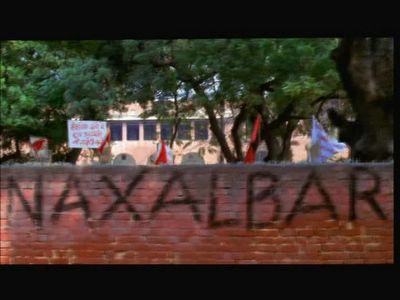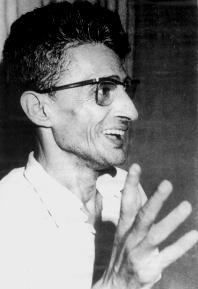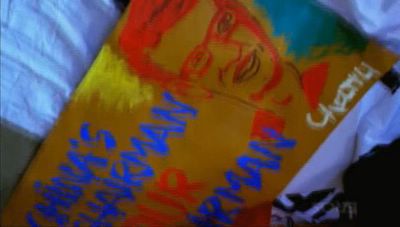Tuesday, June 07, 2005
Hazaaron Khwaishein Aisi(Thousand Desires such as this) - part1
check out my previous post on this movie.
I thought of writing a review about Haazaron khwaheishein aisi.But this is a wonderful movie which like heyram weaves the story with the political situations of a different time period and you have to know that time period to completely appreciate the movie.So here is something about the time period and other backgrounds of the movie.
The decade that the movie is talking about is an important one in the political history of india.Great things happened during that time period.For all those people who were fed up with the socialist regime of congress there was two opposing ideologies available, the armed resistance of Naxalbhari and the peaceful change by JP(Jai Prakash Narayan) 'Total Revolution' movement.And off course, emergency the biggest blotch on india's democratic record happen in that time period.
 sidtharth's group walking near a wall with the "Naxalbhari - Lal salam" graffitti.
sidtharth's group walking near a wall with the "Naxalbhari - Lal salam" graffitti.
The movie starts with sidharth's letter to geetha.
 charu mazumdhar
charu mazumdhar
you can listen to the people in sidharth's house mentioning about the naxal movements in calcutta and charu mazumdhar. When there talk goes to villages. They mention that “charu babu” has told that alongside trade unions and party workers, the farmers should also be armed. In 1967 the event of Naxalbhari rocked the country. The naxabari violence was put down but naxalism was born, till today the idea that charu mazumdhar sowed is still there.
 sidtharth's protest poster similar to that of charu mazumdhar.
sidtharth's protest poster similar to that of charu mazumdhar.
On the other hand JP who was a gandhi and vino bhave disciple was trying to bring a change by peaceful means.
 Lok nayak Jayaprakash narayan
Lok nayak Jayaprakash narayan
 vikram's wedding procesion crosses a group carying placards of JP
vikram's wedding procesion crosses a group carying placards of JP
Lot of youths were attracted by charu mazumdhar's idea.
charu mazumdhar documents
Read the important events in Naxalbari history here.
Very few movies in india has talked about the naxal movements.
1)Tango charlie -> ajay devegan's flash back talks about this bengali landlord that he protects.The land lords house is attacked by the naxals and they do what was known as "people court" .where justice was given by the naxals.
2)Haazar chaurasi ki maa -> This is probably the best movie that gave a close up look of a naxal mindset and kind of romanticized their armed struggle.Govind nihalani is someone who has taken many movies were naxal or armed resistance by the down trodden are mentioned and this is the best of all.This particular movie should have definitely impacted sudhir mishra.This movie talks about a group of bright students who take up armed resistance and a mother's view of it.The movie is set in the 1970-72 during the naxal movement in calcutta.It's a wonderful movie will write about it later.
3)Lal salam - havn't seen this movie.but heard one hard hitting movie about naxals.

I thought of writing a review about Haazaron khwaheishein aisi.But this is a wonderful movie which like heyram weaves the story with the political situations of a different time period and you have to know that time period to completely appreciate the movie.So here is something about the time period and other backgrounds of the movie.
The decade that the movie is talking about is an important one in the political history of india.Great things happened during that time period.For all those people who were fed up with the socialist regime of congress there was two opposing ideologies available, the armed resistance of Naxalbhari and the peaceful change by JP(Jai Prakash Narayan) 'Total Revolution' movement.And off course, emergency the biggest blotch on india's democratic record happen in that time period.
 sidtharth's group walking near a wall with the "Naxalbhari - Lal salam" graffitti.
sidtharth's group walking near a wall with the "Naxalbhari - Lal salam" graffitti.The movie starts with sidharth's letter to geetha.
Yes they were the best and brightest of bengal.Lot of students participated in the naxal activities during that time period.Some left there houses and moved to villages to carry on the struggle.The violence even spread to the cities and calcutta became the center of urban violence.Read about the experience of one student here.Dear Geetha,
Calcutta was awe inspiring. My beliefs totally strengthen. We have to change the world, and change it fundamentally. You know i always knew the fact, but when i met some of the mothers and widows of thousands of students who have sacrificed their lives during the naxalite movement, i felt completely humbled. They were the best and brightest of bengal.
 charu mazumdhar
charu mazumdharyou can listen to the people in sidharth's house mentioning about the naxal movements in calcutta and charu mazumdhar. When there talk goes to villages. They mention that “charu babu” has told that alongside trade unions and party workers, the farmers should also be armed. In 1967 the event of Naxalbhari rocked the country. The naxabari violence was put down but naxalism was born, till today the idea that charu mazumdhar sowed is still there.
 sidtharth's protest poster similar to that of charu mazumdhar.
sidtharth's protest poster similar to that of charu mazumdhar.On the other hand JP who was a gandhi and vino bhave disciple was trying to bring a change by peaceful means.
 Lok nayak Jayaprakash narayan
Lok nayak Jayaprakash narayanHe later launched the anti corruption movement against Indira gandhi which eventually lead to the regime change at the center.In June 1971, Sarvodaya workers in Muzaffarpur, Bihar, received a letter threatening to kill them. The area was continuously threatened by Naxalites, which was made up of young men. Jayaprakash walked into the heart of Naxal territory armed only with love and sympathy. He knew that the cause of the violence was that the youth were frustrated because of poverty and unemployment. He lived in Musahari block for many months and experimented to alleviate the problems of the Naxals.more
 vikram's wedding procesion crosses a group carying placards of JP
vikram's wedding procesion crosses a group carying placards of JPWhat exactly is this Naxalite movement and what is its ideology?
The Naxalite ideology is broadly based on the late Comrade Charu Majumdar's historic Eight Documents and creative application of Marxism-Leninism-Mao Tsetung thought to Indian conditions. The documents are historic as they initiated a sharp departure from parliamentary democracy and put forward revolutionary politics to win justice and end oppression.
The Naxalbari uprising of March 1967 saw the implementation of Charu Majumdar's vision of revolution. The armed peasants' struggle began in Naxalbari in West Bengal on March 2, 1967 when a tribal youth named Wimal Kesan, who had a judicial order, went to plough his land. Local landlords attacked him through their goons. This sparked wide-scale violence by tribals who started capturing back their lands. In the 72 days of Charu Majumdar-backed tribal violence and retaliatory action by the state, the incident echoed throughout the country and Naxalism was born.
The ultra-leftist Naxalite ideology took concrete shape in a May 1968 meeting of All India Coordination Committee of Communist Revolutionaries (AICCCR) which represented revolutionaries from seven states of Tamil Nadu, Kerala, UP, Bihar, Karnataka, Orissa and West Bengal. In 1969, a Communist Party (Marxist-Leninist) was formed under the leadership of Charu Majumdar. It argued that democracy in India was a sham and decided to base Indian revolution on protracted guerrilla warfare on the lines of Chinese model. Who was this Comrade Charu Majumdar and what were his eight documents?
Comrade Charu Majumdar's was born in a progressive landlord family in Siliguri in 1918. He not only dedicated his entire life to peasants' cause but also authored the historic 1968 Naxalbari uprising, the ideology which guides the Naxalites even today. Dropping out of college in 1937-38 he joined Congress and tried to organise bidi workers. He later crossed over to CPI to work in its peasant front and won respect of the poor of Jalpaiguri. Soon an arrest-warrant forced him to go underground for the first time as a Left activist. Although CPI was banned at the outbreak of World War II, he continued CPI activities among peasants and was made a member of CPI Jalpaiguri district committee in 1942.The promotion emboldened him to organise a 'seizure of crops' campaign in Jalpaiguri during the Great Famine of 1943, more or less successfully. In 1946, he joined Tebhaga movement and embarked on a proletariat militant struggle in North Bengal. The stir shaped his vision of a revolutionary struggle. Later he worked among tea garden workers in Darjeeling.He was again jailed during the 1962 Indo-China war as part of curbs on all Left activities in India.
Charu Majumdar's was in bad health during the 1964-65 period and was advised rest. But he devoted his time, even in jail, to study and write about Mao's thoughts. The exercise shaped his vision and ideas of a mass struggle, which were recorded in his writing and speeches of 1965-67. These were later called 'Historic Eight Documents' and subsequently formed the basis of Naxalism. On May 25, 1967, the CM-led "rebels" launched the historic peasant uprising at Naxalbari in Darjeeling district of West Bengal. It was "brutally" suppressed by the state government but the ideology of "Naxalism" not only survived but also spread. With the upsurge of Naxalism, comrades from Tamil Nadu, Kerala, UP, Bihar, Karnataka, Orissa and West Bengal set up All India Coordination Committee of Revolutionaries (AICCR) in CPI (M) on Nov 12-13, 1967. It was renamed as All India Coordination Committee of Communist Revolutionaries, which launched CPI (ML) on April 2, 1969 with Comrade Charu Majumdar as its General Secretary.
A fierce crackdown by the authorities on ultra-Leftist movement in India's West Bengal and Andhra Pradesh states, (which climaxed during and after 1971 Bangladesh war) saw the killings of many key ultra-Leftist leaders and ailing Comrade Charu Majumdar had to go underground. By 1972 he was India's most wanted man. Charu Majumdar was arrested from a Calcutta hideout on July 16, 1972 and died twelve days later, on July 28, 1972, in police custody in the Lal Bazar lock-up infamous for its torture chambers where he was tortured while being held incommunicado.
His 'brain-child' Naxalism -- the ultra-leftist manifestation of age-old peasant struggle in India -- did not die after Comrade Charu Majumdar's judicial murder but the saga of terror and violence, by the land-less oppressed against the oppressor, that it entails has continued over the decades in different parts of India despite severe official crackdown on it by a police/landlord/Bania nexus.The movement continues to grow, in both its political and violent forms, in backward and tribal areas of Madhya Pradesh, Andhra Pradesh, Bihar, Jharkhand, Maharashtra, Orissa and some parts of Tamil Nadu.
Of the many Maoist organisations in India, the People's War and MCC are at present engaged in armed struggle against "the ruling classes and oppressive state forces" in AP, Bihar and adjoining areas.
Lot of youths were attracted by charu mazumdhar's idea.
That is a typical communist propoganda stuff.But still there is lot of truth in it.In Punjab, Bihar, UP, Tamilnadu, Kerala and even amongst the Campuses of Delhi and Bombay thousands of youth were attracted to Maoism and the politics of Naxalbari. Naxalbari symbolised to this youth a new future of justice, truth, equality, humanity and a self-respect for the downtrodden. Fired with this missionary-like zeal they set out to exterminate the perpetrators of injustice, ....... to execute the executioners. They sought to create a paradise on earth. They shared the on dreams of their leader, affectionately known as CM(charu mazumdar), to create a bright future where no person shall go hungry; where no one shall oppress another, where there shall be no discrimination based on caste, religion or sex; where a new socialist human being will be born in whom greed, selfishness, ego, competitiveness will be replaced by selflessness, modesty and cooperation, and where a concern for others will take precedence over concern for oneself. And it is these youth who, together with the more experienced leaders, marched forth to turn their dreams into reality, by building Naxalbari-type struggles in many parts of the country.more
charu mazumdhar documents
Read the important events in Naxalbari history here.
Very few movies in india has talked about the naxal movements.
1)Tango charlie -> ajay devegan's flash back talks about this bengali landlord that he protects.The land lords house is attacked by the naxals and they do what was known as "people court" .where justice was given by the naxals.
2)Haazar chaurasi ki maa -> This is probably the best movie that gave a close up look of a naxal mindset and kind of romanticized their armed struggle.Govind nihalani is someone who has taken many movies were naxal or armed resistance by the down trodden are mentioned and this is the best of all.This particular movie should have definitely impacted sudhir mishra.This movie talks about a group of bright students who take up armed resistance and a mother's view of it.The movie is set in the 1970-72 during the naxal movement in calcutta.It's a wonderful movie will write about it later.
3)Lal salam - havn't seen this movie.but heard one hard hitting movie about naxals.


